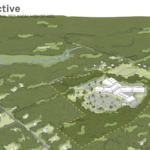Editor’s note: The views and opinions expressed in this article do not reflect those of the Carver Journal. Andrew Mikula is a senior housing fellow at the Pioneer Institute, a public policy think tank based in Boston.
On Tuesday, Carver Town Meeting will vote on a proposed zoning bylaw amendment (Article 8) needed to comply with the MBTA Communities Act (Section 3A), a state law requiring 177 cities and towns to designate a zoning district for multi-family housing. A recent Pioneer Institute study offers a detailed examination of the enforcement and potential impact of the law and profiles implementation efforts in select communities. The insights from this research could provide some valuable framing for the Town Meeting discussion.
Affordability
A common complaint about Section 3A is that it doesn’t provide truly affordable housing and thus is best described as a giveaway to developers. It’s true that Section 3A doesn’t prioritize creating housing whose occupants are explicitly subject to income limits. Instead, 3A aims to help make housing broadly more affordable by facilitating additional construction, including market-rate housing.
Pace of Change
Some towns complying with Section 3A have seen a faster-than-anticipated pace of applications from developers. Lexington, for example, has received proposals for more than 1,100 new housing units since approving its new zoning overlay districts in April 2023. However, Lexington went far beyond the minimum requirements under Section 3A, initially applying the new zoning to 227 acres instead of the state-mandated 50. Studies have found that typically no more than 2 percent of properties are redeveloped per year after a substantial loosening of zoning regulations.
Infrastructure and Schools
Some service costs associated with Section 3A, such as for emergency personnel and equipment, will be borne at the local level. But providing water and wastewater infrastructure sufficient to serve new housing is the developer’s responsibility. Neither Section 3A itself nor the state’s 3A guidelines force municipalities to provide that infrastructure. Meanwhile, the relationship between housing development and school enrollment changes is empirically tenuous, and further tempered by the fact that 71 percent of traditional public school districts in Massachusetts have seen declining enrollment in the past 10 years.
Fiscal Health
Relatedly, cities and towns should not take it for granted that new residential development is always fiscally positive or always fiscally negative. In a 2019 UMass Dartmouth study, of a representative sample of new housing developments in Massachusetts, 29 percent had net negative fiscal impacts on the municipal level. Other academic research has found that multi-family housing developments are particularly likely to produce more local revenue in taxes and excises than they cost in local services provided.
Traffic
Any new housing development resulting from Section 3A will tend to increase traffic congestion in the immediate vicinity. According to the 10th edition of the Institute of Transportation Engineers Trip Generation Report, multi-family homes typically generate seven daily vehicle trips per unit, compared to 10 daily trips per single-family home per day and 38 daily trips per 1,000 square feet of retail. To the extent that Section 3A zoning districts are located in village-like, transit-oriented areas, the resulting housing developments will likely produce less traffic than a similar project allowed under current zoning.
Enforceability
While Section 3A’s implementation was delayed due to procedural errors, arguments that the law is an “unfunded mandate” or otherwise unconstitutional have been dismissed by Superior and Appellate courts, respectively. Massachusetts’ Constitution already authorizes the state to restrict local zoning, and there is a decades-long precedent for such restrictions. Cities and towns can avoid compliance for perhaps a few months by refusing to adopt the required zoning changes. But they’re also risking getting sued by the state, paying the resulting legal fees, and losing access to state grant money. As of September 18th, only 15 of the 177 communities subject to the law are out of compliance.
“Solving the Housing Crisis”
Proponents of Section 3A often invoke supply and demand to argue that lowering housing prices requires policies that encourage building more housing in general. There is strong academic evidence that this claim has merit, although Section 3A alone is unlikely to bring housing supply and demand into balance in Massachusetts. In August, the Healey administration reported that 5,200 homes have been built or proposed under Section 3A so far – not exactly on pace to meet the projected need for 222,000 new homes by 2035.
The fact that Section 3A has an insufficient scope to solve the state’s housing challenges doesn’t make it bad policy. It just means that additional measures are needed to ensure that every Massachusetts family can find an affordable home that suits their needs. Regardless of the outcome of next week’s Article 1 vote, the urgency and daunting magnitude of Massachusetts’ housing shortage is clear. Readers of Carver Journal should stay informed of housing issues in Carver and beyond.
If you’d like to submit your own opinion piece, contact opinions@carverjournal.com.


